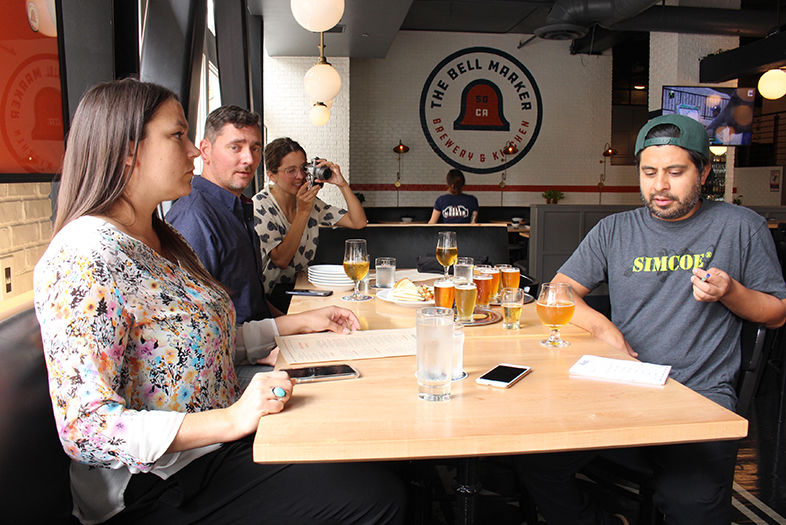With the exception of sausage and root canals, I believe it’s always a good thing to see firsthand how something is done. I spend a great deal of time tasting and evaluating the beer of others, but I spend very little time actually watching beer get made or making beer of my own. And, while I certainly appreciate all the skill and effort that goes into creating a craft beer, it’s not until you actually go through all the steps yourself that you truly understand what’s involved.
Just recently, I took the opportunity—along with some of my colleagues from San Diego Magazine—to create a collaboration beer with veteran local brewer Nacho Cervantes. Nacho and The Bell Marker on Broadway have started to reach out to their neighbors and local businesses in an effort to create collaboration beers that neighbors and locals alike would be excited about drinking. So about two weeks ago, I sat down with Nacho, and San Diego Magazine staffers David Martin, Lauren Pettigrew, and Lauren Winget to start the discussion about what kind of beer we wanted to create.
One of the most fun aspects of doing a collab is the fact that pretty much the entire world of beer is wide open to you. So, homing in on a basic style and some key flavor characteristics is usually the first order of business.
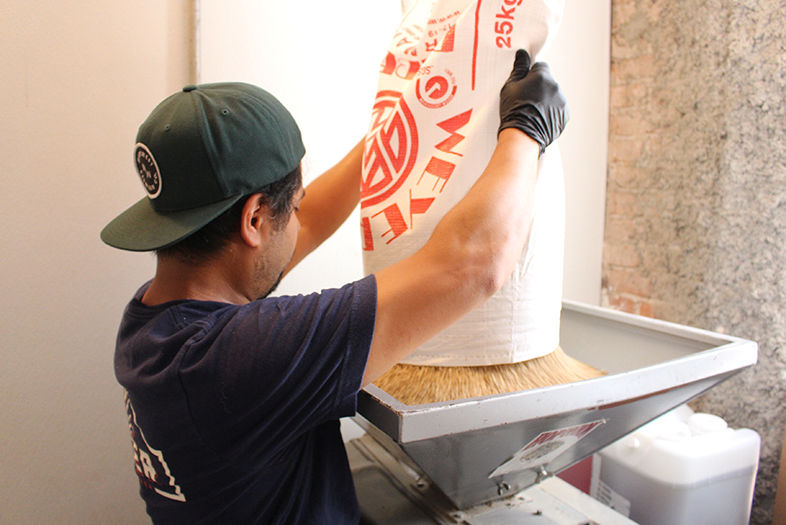
‘San Diego Magazine’ Makes a Beer
Nacho empties a bag of base malt into the milling machine on brew day. | Photo: Bruce Glassman
Okay, so it’s summer and it’s been heinously hot during the past few weeks, so imperial stouts and porters were out. Reds and browns? Maybe, but we worried that those styles are less appreciated in general and the beer would not move fast enough. IPA? Nah. Everyone does that. A hazy beer? Too trendy. We finally decided that saison was the perfect style to brew for end-of-summer sipping. But how to make it different? How about we fruit it up with something? We talked about everything from mango to passionfruit to pineapple and guava. We finally settled on a cool mix of grapefruit, blood orange, and pomegranate. In addition to adding delicious citrus notes, these adjuncts would also (hopefully) make the beer a super-cool pinkish-orange color. To support this idea, we also decided to pump up the caramel malt a bit, which will help get the beer closer to orange-amber. With adjuncts and basic malt strategy decided, we needed to make some decisions about hops and yeast. Some of the hopping decisions would be made a little later in the process, to determine dry hopping, but we needed to figure out how hoppy we wanted the finished beer to be. If we wanted restrained hop aromas and flavors, that would indicate the use of certain varieties; if we wanted big aromas and lots of bitterness, that would point us toward other varieties.
And finally, there was the yeast question. The kind of yeast you use in fermentation is actually a huge factor in determining how your finished beer will turn out. It affects just about everything, from aroma to flavor to alcohol levels to sugar levels, even appearance. You virtually can’t make a saison without some kind of Belgian strain, because those are the strains that create the floral and bready esters, citrus and tropical flavors, and “black pepper” spiciness that are the hallmarks of the style. Nacho decided to go for a common Belgian yeast strain that he knew he could get in time from local supplier White Labs.
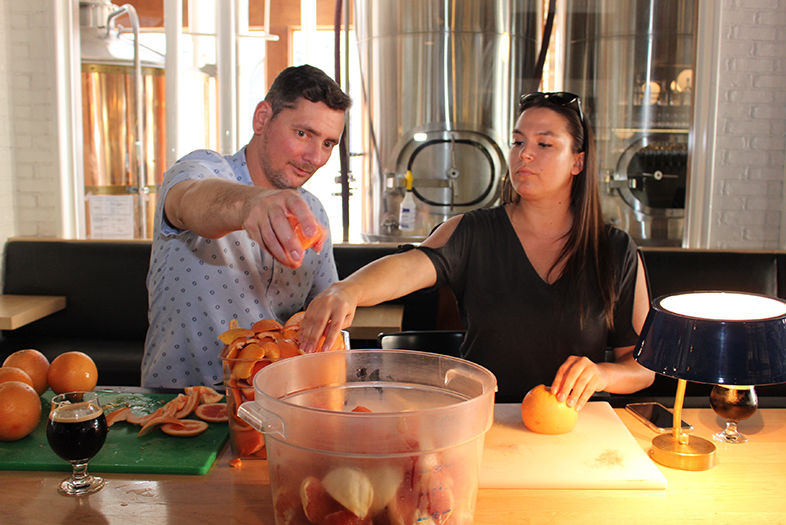
‘San Diego Magazine’ Makes a Beer
David and Lauren take part in the fresh fruit prep work. | Photo: Bruce Glassman
On brew day, we showed up early in the morning to get the process started—start to finish is commonly 8–10 hours. Nacho had already been there for a while, prepping ingredients and getting the equipment ready to use. He had also written up a basic recipe, adapted from similar ones he’d done in past, but augmented to create the characteristics we’d discussed. The first ingredients he pulled together were the bags of grain we were going to employ as our grain bill. Nacho decided on exactly what the mix of malts would be and in what proportion they would be used. Our beer was going to be mostly lighter pilsner base malt, but would also include a mix of Crisp 77, Maris Otter, Crisp 45, and Simpson T50 malts. Some acidulated malt would also be used, to balance the overall acidity of the brew. For extra mouthfeel, Nacho pulled out a bag of rolled oats and a bag of flaked wheat. Each of those bags got emptied directly into the hot water of the mash tun while the malts went into the milling machine, where they were gently crushed and conveyed into the mash tun for steeping along with the oats and wheat.
While the grains were soaking (at this point it looks like a gigantic bowl of oatmeal) the magazine team set to work peeling, seeding, and sectioning the fresh fruit we were going to add during the next stage of the process. I realized, while prepping, just how much extra work it is to do a fruited beer. After peeling and chopping 100 pounds of orange, grapefruit, and pomegranate I had an epiphany: I will forever drink my fruited beers with a newfound appreciation for the time and effort that goes into them!
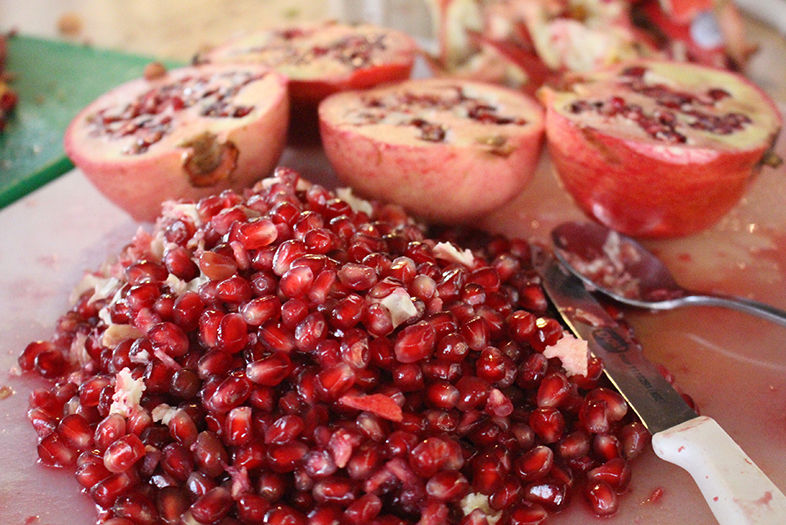
‘San Diego Magazine’ Makes a Beer
Fresh pomegranate seeds add a subtle tangy crispness to the brew. | Photo: Bruce Glassman
Once the wort (the hot, sweet, malty tea that’s extracted from the grains) had been transferred from the mash tun to the kettle, it was time to start the boil. This is when the hops are added (at different stages for different reasons) as well as any adjuncts or extra flavor ingredients. The first addition of hops, done early in the boil, is for bittering. We mixed in about two pounds of a super-cool hop variety called Styrian Wolf, which has a good alpha acid level for bittering and also has deep, rich, earthy, citrus, and spicy aromas. We also added our “giant teabag” filled with fresh fruit and about a cup of crushed coriander seeds. (Coriander is a traditional spice for saison.) Then it was time to wait. Most boils go about 60 minutes; Nacho wanted this boil to go 75.
The later hop additions—at the very end of the boil or in the fermentation tank—are for aroma and flavor. When the boil was nearly done, we did our major hop dump of five more pounds of Styrian Wolf and five pounds of Mosaic, which imparts bigger citrus flavors and aromas. Once the hops are in, the liquid must be chilled way down very quickly and transferred to a fermentation tank where, with the addition of yeast, the magical process of creating alcohol takes place.
Then it’s more waiting—this time for about 10 days.
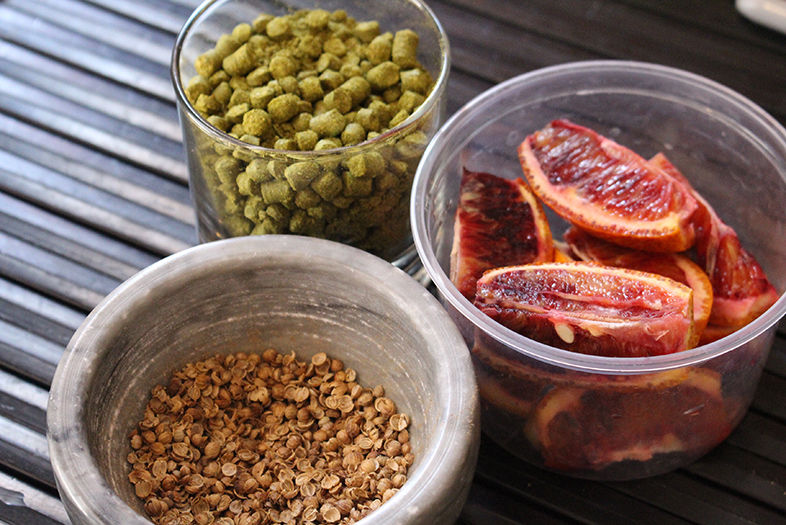
‘San Diego Magazine’ Makes a Beer
Some of the saison’s flavor components include hops, freshly ground coriander, and fresh sections of blood orange. | Photo: Bruce Glassman
The final step in our creation process entailed tasting the beer out of the tank once fermentation was complete. This is when we’re able to adjust certain aspects of the beer, such as hop profile or fruitiness, if we feel it’s necessary.
Out of the tank, the beer was light apricot colored and had enticing aromas of toasted bread, clove, banana, grapefruit, orange, and black pepper. The Belgian character shined through nicely on the nose, but we decided we wanted to punch up the hop aroma a bit more, to balance with the Belgian esters. After doing a couple of tiny taste tests in individual glasses, Nacho decided he would add about half a pound of hops per barrel to the fermenter as a dry hop addition. Those hops sit in the beer for a few days to impart their fresh and pungent aromas.
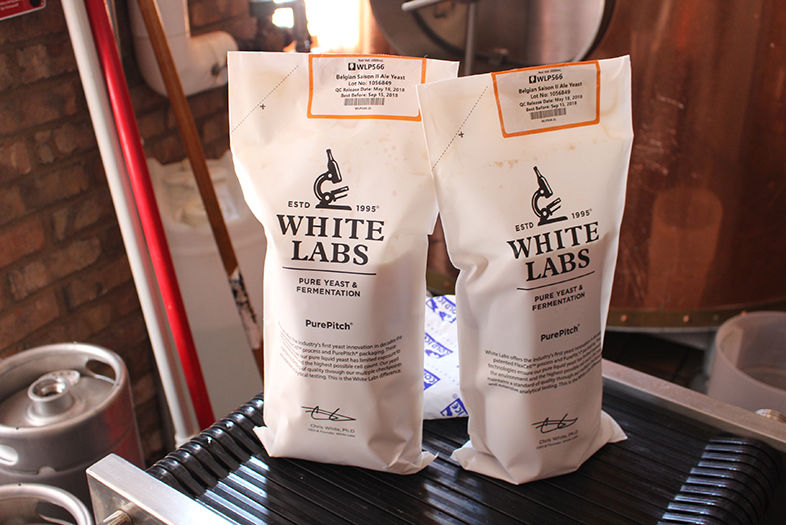
‘San Diego Magazine’ Makes a Beer
Saison yeast from White Labs in Miramar was used for fermentation. | Photo: Bruce Glassman
Flavor-wise, the saison had a great mouthfeel and wonderful notes of blood orange, grapefruit, and spice. Bitterness levels were good, but the yeast we used had fermented the beer very dry, so we decided to round out the finish a bit. After more taste tests and deliberations, we decided that a small addition of blood orange purée would give the finish the subtle hint of sweetness we desired. Nacho calculated the proper amount of purée to add, and that went into the tank as well.
This saison story is not yet complete. As our brew sits on fresh hops in the tank, it will acquire a bigger, bolder hop complexity before being transferred to a bright tank for service. The exact amount of time needed for this beer to be deemed “ready” is uncertain, but, as soon as Nacho says it’s done, we’ll let everyone know (likely the last week of August). At that time, we’ll announce what our beer has been officially named and also how we plan to release it to the public. When it’s ready, we’d love to have all our readers and beer fans come out to The Bell Marker to taste what happens when a brewer and a bunch of beer-loving magazine folks join forces to create their special version of a great summer beer! Stay tuned.
Follow Bruce:
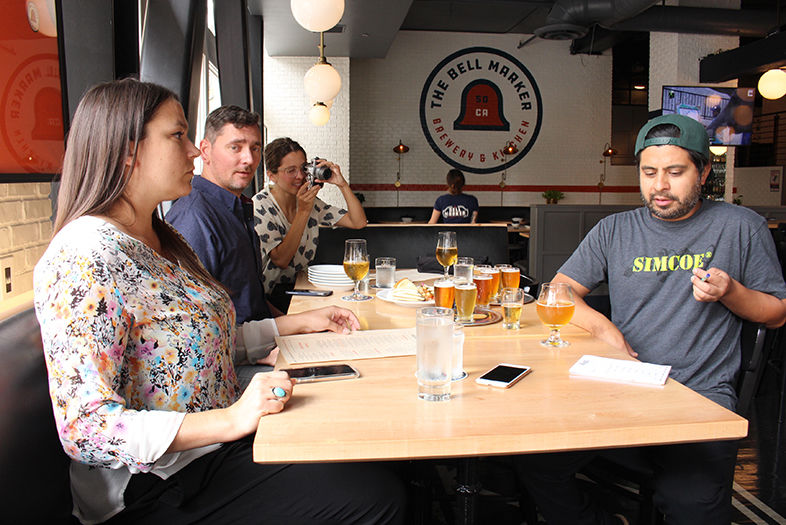
‘San Diego Magazine’ Makes a Beer
PARTNER CONTENT
San Diego Magazine staffers Lauren Pettigrew (front), David Martin (center) and Lauren Winget (back) met with The Bell Marker’s brewer, Nacho Cervantes, to formulate the concept and strategy for a special collaboration beer.









